The Witness Within: How Body Cameras Changed Officer Psychology
By Parth B. · ~30 min read
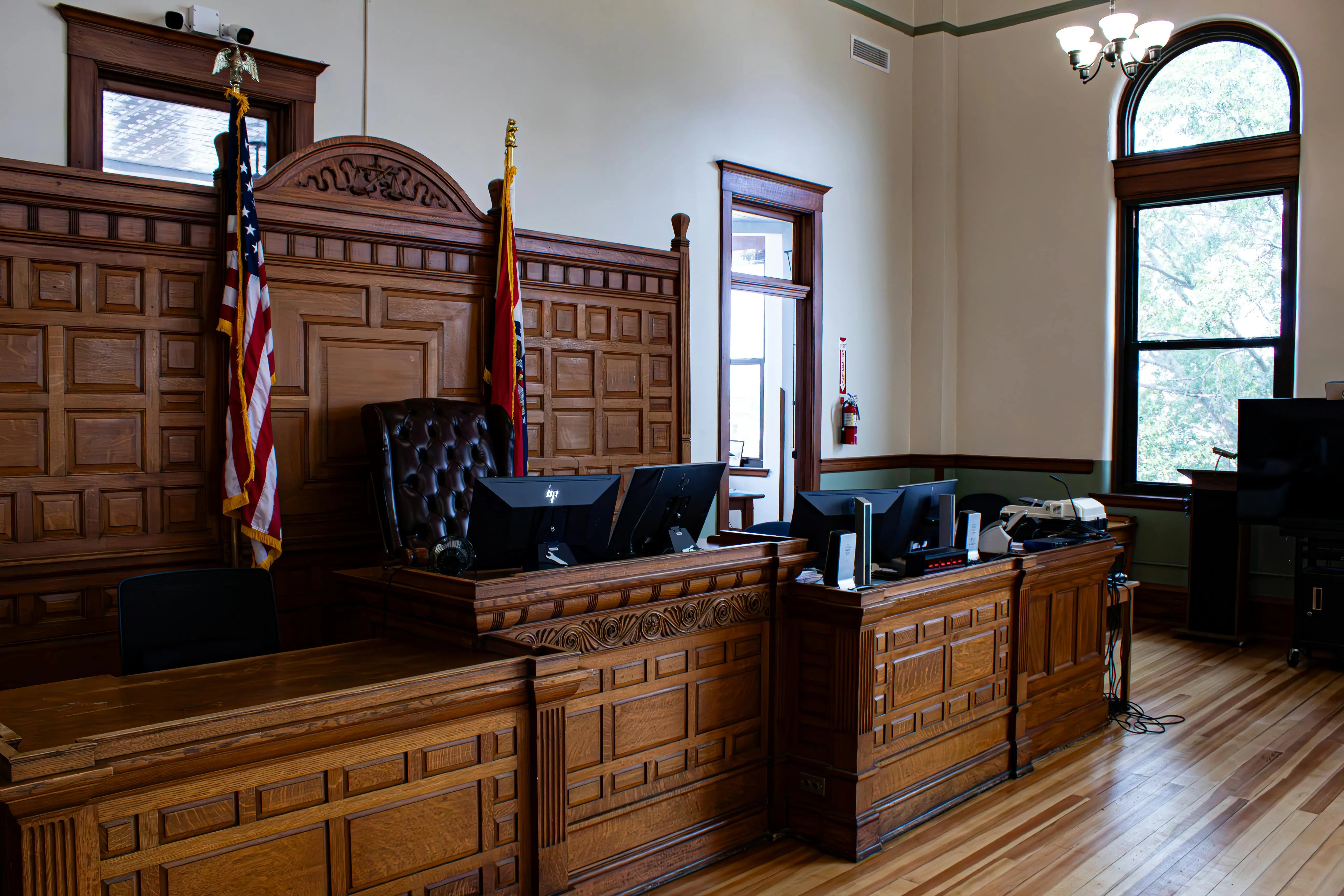
Body-worn cameras have rapidly evolved from a novel experiment to standard equipment in U.S. law enforcement. These small devices attach to an officer's uniform and record video and audio from the officer's point of view during traffic stops, arrests, and other encounters. Over the past decade, widespread public support and policy initiatives have driven the adoption of police body cameras across the country. By 2016, nearly half of U.S. law enforcement agencies had implemented body camera programs, including about 80% of large police departments. Today, most major departments equip officers with "the witness within" – an ever-present camera that documents their actions. This article explores how these cameras have shaped modern policing, particularly from the officer's perspective. We will look at a brief history of body camera adoption, then examine their impact on officer psychology, daily behavior, public interactions, and legal procedures. The goal is to provide a balanced, educational view of how body cameras have influenced police work – often for the better – while acknowledging challenges and changes in officer mindset along the way.
A Brief History of Body Cameras in U.S. Policing
Although portable video cameras have existed for decades, police use of body-worn cameras (BWCs) is a relatively recent development. The first U.S. police body camera pilot programs began around 2012. Early trials – such as one in Rialto, California – reported dramatic drops in use-of-force incidents and citizen complaints when officers wore cameras. These initial successes kickstarted a wave of adoption. Following public outcry over the 2014 police shooting of Michael Brown in Ferguson, Missouri, political momentum surged in favor of body cameras. In late 2014, President Obama proposed $75 million in federal grants to help law enforcement agencies purchase body cameras, aiming to outfit 50,000 officers within three years. This infusion of funding enabled even small and rural police departments to acquire the technology by subsidizing the costs of cameras, data storage, and support infrastructure. [Source]
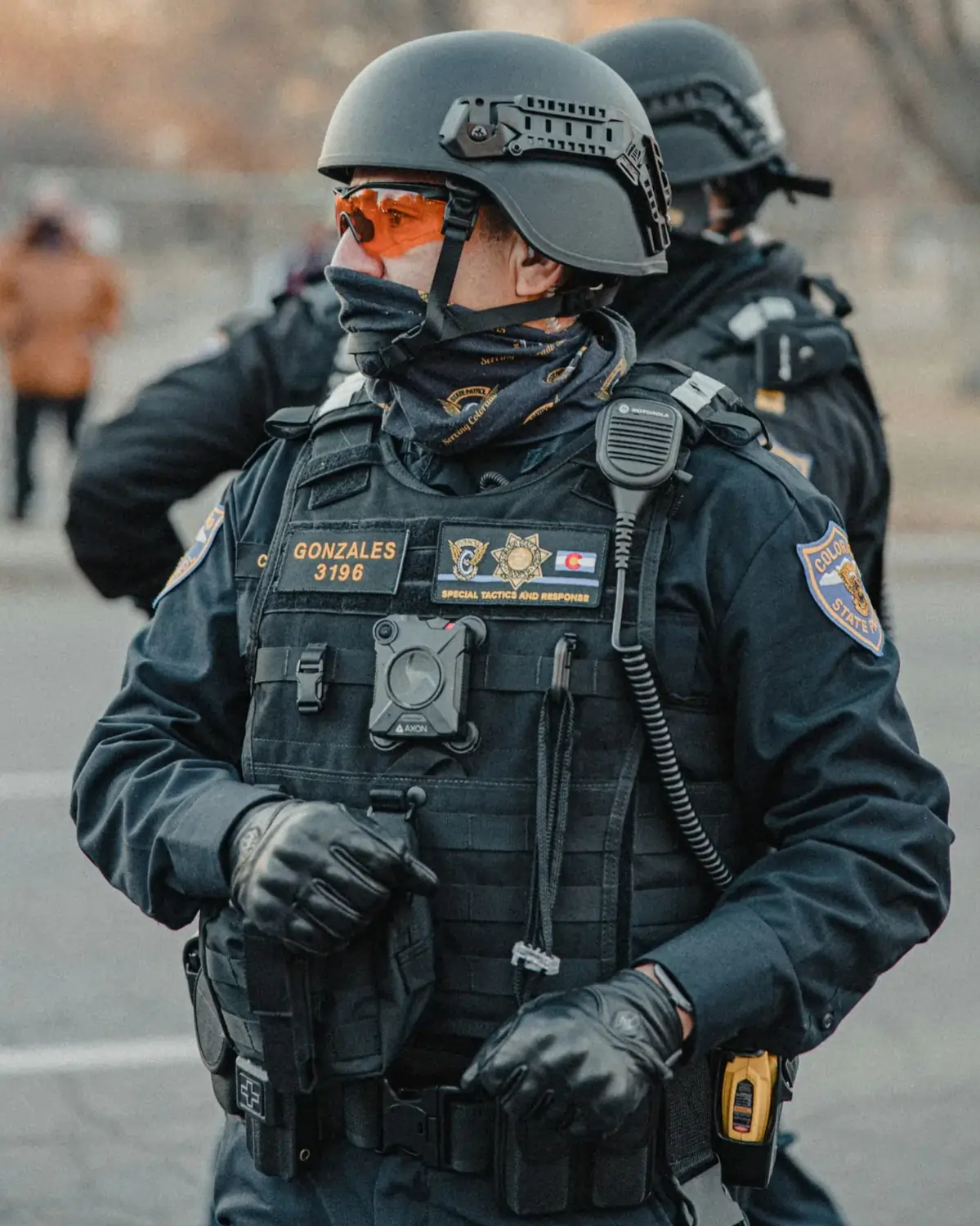
Officer Gonzales patrols in full tactical gear, carrying the weight of both protective equipment and responsibility. Behind the helmet and body armor is a person who faces danger to keep communities safe - a human reality that extends far beyond what any bodycam lens can capture.
Public support for body cameras during this period was overwhelming. An April 2015 national poll found that 88% of Americans supported requiring police to wear body cameras. This reflected hopes that cameras would improve transparency and trust. As one policy analyst noted, cameras were seen as a "win-win," potentially protecting the public from police misconduct and protecting police from false accusations by creating an objective video record of encounters. Indeed, a study by George Mason University found that officers themselves believed the cameras helped collect evidence and shield them from unfounded complaints, with both officers and citizens feeling that bodycams "protect them from each other". [Source]
By the mid-2010s, body cameras transitioned from rarity to routine. Major cities like Washington D.C., New York, and Los Angeles launched pilot programs in 2014, and many others followed suit. The Bureau of Justice Statistics reported that by 2016, 47% of the roughly 15,300 general-purpose law enforcement agencies in the U.S. had acquired body-worn cameras. For large municipal police departments, adoption was even higher – about 80% were using body cams by that time. In just a few years, what began as a niche experiment became standard operating procedure in policing. Today, nearly all big-city departments and a growing number of smaller agencies deploy body cameras, driven by goals of increasing officer safety, improving evidence collection, reducing citizen complaints, and enhancing accountability. [Source]
Behind this rapid uptake were both technological and social forces. Technologically, the late-2000s smartphone boom led to smaller cameras, better batteries, and cheap data storage – making durable, wearable police cameras feasible and affordable. Socially, high-profile use-of-force incidents and the resulting protests created grassroots demand for greater police transparency. Community members and civil rights groups argued that if officer encounters were recorded, it would resolve the "he-said, she-said" ambiguity of police incidents and deter misconduct on both sides. As a result, many states began passing laws or guidelines for body camera use. For example, South Carolina in 2015 became one of the first states to mandate that all law enforcement agencies implement body cameras and set minimum standards for usage, data retention, and privacy. Other states set guidelines without full mandates, encouraging agencies to adopt the technology in a way that addresses local needs.
Crucially, early adoption was accompanied by evolving policies and training. Initially, many departments had no formal procedures on when to activate cameras, and officers sometimes simply forgot to turn them on during calls. Over time, departments established clear activation rules (for instance, requiring recording during any law-enforcement encounter) and even introduced technological safeguards – such as cameras that automatically begin recording when a patrol car's lights are activated or a Taser or firearm is unholstered. Departments also developed rules for handling the footage and defined who could access it. By 2016, about 86% of agencies with body cams had a formal policy governing their use. These policies helped integrate cameras into everyday policing and addressed concerns about privacy and consistency. By the late 2010s, body cameras were firmly embedded in U.S. policing culture, backed by broad public endorsement and an expectation of transparency.
From Skepticism to Acceptance: The Psychological Impact on Officers
The introduction of body cameras brought not only new equipment but also new psychological pressures for officers. In the early days, many front-line officers were wary of the "always-on" scrutiny that cameras represented. Police have long operated with a great degree of autonomy on the street, so the idea of every interaction being recorded – and potentially judged after the fact – naturally raised concern. Law enforcement agencies initially viewed body cameras with caution, with officers worried about "being micromanaged, second-guessed, and constantly watched" by supervisors and the public. This sense of always being under observation led to increased stress for some officers, especially in agencies that implemented cameras without emphasizing a supportive culture. Research has confirmed that wearing a body camera can elevate stress levels if officers feel the footage might be used punitively rather than as a tool for learning or protection. In one study, officers reported that intense electronic monitoring (like bodycams) contributed to higher burnout and lowered their sense of organizational support – essentially feeling that "Big Brother" was watching without having their back. However, that same study noted an important caveat: when police felt their department's leadership supported them and used camera footage fairly, it blunted the negative stress effects. In other words, strong organizational support and clear policies can turn body cameras from a source of anxiety into a source of confidence. [Source]
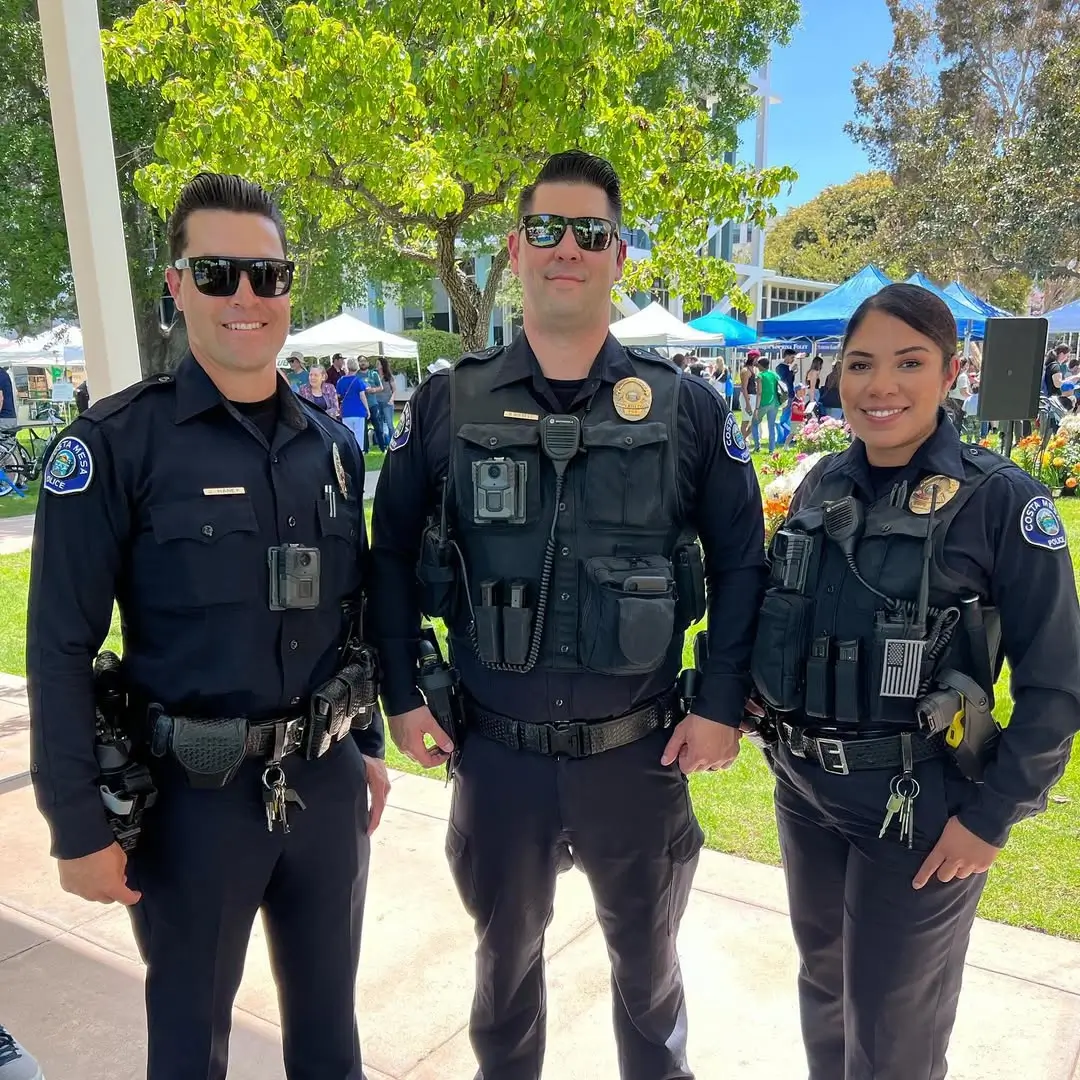
Costa Mesa Police officers connect with their community at the Earth Day Festival. These positive interactions at local events help build trust and show the friendly faces behind the badge - moments of connection that strengthen the bond between police and the neighborhoods they protect.
Photo credit: Costa Mesa Police Department | Source: @costamesapd Instagram
Officer concerns in the early adoption phase were multifaceted. Many feared that body camera footage would be used primarily to catch mistakes and punish officers, rather than to support them or capture good police work. In surveys during initial rollouts, over half of officers said they worried that cameras would limit their discretion in the field and invite Monday-morning quarterbacking of split-second decisions. There was also apprehension that videos could be taken out of context – a camera might not capture the suspect's angle or the threat an officer perceived, yet the officer could still be judged harshly by those viewing the footage later. As Boston's police commissioner William Evans expressed at the time, some officers feared citizens might be less willing to engage or share information if they knew they were on camera. In short, early on, many officers felt body cams were a double-edged sword: a tool that might improve accountability, but also one that could be used against them if misunderstood.
Over time, however, attitudes among officers began to shift as they gained experience with body cameras. As more cameras hit the streets and departments refined their policies, police started to see concrete benefits. One of the biggest psychological reliefs was the realization that body camera footage could quickly disprove false complaints and protect officers from wrongful allegations. Prior to bodycams, an officer could be subject to a serious accusation by a suspect or citizen with little evidence beyond conflicting stories. Now, if an interaction is unfairly called into question, the recorded video often validates that the officer acted properly. Many officers take comfort in knowing "the camera doesn't lie" – if they are following their training, the footage serves as an impartial witness to back them up. Law enforcement leaders have reported that bodycam video has exonerated officers accused of misconduct in numerous cases, strengthening officers' faith in the technology as a safeguard for them as well as for the public.
As a result of these experiences, body cameras gradually gained acceptance and even support within police ranks. Surveys in recent years show that a solid majority of officers now favor the use of body-worn cameras. In a nationwide Pew Research Center poll, 66% of officers said they support police use of body cameras. Notably, this support was highest among command staff (over 80% of police administrators favored bodycams) but was also about two-thirds among rank-and-file officers. Many officers have come to view the bodycam as just another part of the uniform, as routine as a radio or handcuffs. With clear department policies in place, officers know when to turn the camera on and have guidelines for handling sensitive situations. The initial fear of relentless surveillance has eased in many agencies, replaced by a sense that cameras can be "indispensable public safety tools" when used properly. In interviews, officers often cite that cameras help bolster professionalism and accountability, which ultimately makes their jobs easier. One patrol officer put it simply: "The body camera is my unbiased witness. It keeps me honest, and it keeps the people I deal with honest." That growing trust in the technology has been reflected in everyday police culture – new recruits are now trained from the start to use body cameras, and wearing one has become second nature. [Source]
None of this is to say the psychological impact is uniformly positive or negligible. The presence of a camera inevitably adds a layer of pressure to police work. Even experienced officers acknowledge a heightened sense of responsibility, knowing that any lapse in protocol or any stressful incident will be preserved on video. Officers have described an acute awareness at critical moments that "this will be on camera," which can be a source of stress but also a reminder to follow training. Some studies suggest that over the long term, constant video monitoring could contribute to officer burnout if not managed well. Agencies have learned that simply deploying cameras isn't enough – they must also foster a supportive environment where footage is used constructively. When supervisors use video to provide coaching and acknowledge good work (not only to find faults), officers feel more supported and view the system as fair. Conversely, if officers sense that every minor mistake caught on camera will be punished, morale can suffer. Thus, a key lesson has been that body cameras are most effective, and least stressful for officers, when coupled with fair policies and department support. Many police departments now involve officers in developing bodycam policies and have clear rules about supervisory review of footage to ensure it's used for improvement and evidence, not trivial discipline.
In summary, the psychological journey for officers adapting to body cameras has gone from early skepticism to a more nuanced acceptance. Initial fears of the "all-seeing eye" have been tempered by experience, as officers see that the camera can validate their good work and filter out false claims. Most officers have adjusted their mindset – they understand that wearing a camera is part of being a modern police professional, bringing both accountability and a measure of protection. The stress of being recorded hasn't disappeared, but it's mitigated by the realization that the camera's presence can also affirm an officer's proper actions and integrity. With time, body cameras have become less of an emotional burden and more of a valued tool in the police toolkit, as long as everyone understands the ground rules.
Altered Behavior: How Body Cameras Influence Officer Conduct
Beyond internal feelings, body-worn cameras have tangible effects on how officers behave in their day-to-day duties. The very knowledge of being recorded tends to encourage self-awareness. A core premise behind deploying bodycams was the "civilizing effect" – the theory that people (both officers and civilians) will behave better when they know they are on camera. In practice, this has often proven true, though not universally so. Many officers report that wearing a camera prompts them to stay more composed and mindful during encounters. Even in heated situations, an officer might think twice before using harsh language or cutting corners on procedure, knowing that their actions are on film and could be reviewed by superiors, a judge, or the public. In a national survey, half of officers said that body cameras would make police more likely to act appropriately in their interactions with the public. (The other half felt cameras would make no difference – reflecting that many officers believe they would behave professionally with or without a camera.) Notably, very few officers (only 5% in the survey) thought wearing a camera would make officers less likely to act appropriately. These findings suggest that the majority of police anticipate either a positive or neutral effect on their conduct, and indeed many embrace the camera as an extension of their commitment to professionalism.
On the street, bodycams have subtly shifted police-community interactions. Officers often announce when encounters are being recorded, which can influence the demeanor of those they interact with. For instance, an officer might inform a motorist during a traffic stop that "our conversation is being recorded." Such statements can have a calming effect: citizens who know they are on camera may be less inclined to become belligerent or may be reassured that the officer is unlikely to mistreat them on video. From the officer's side, the camera can serve as a de-escalation tool. Many departments have found that the presence of a camera tends to encourage more polite and measured dialogue. One reason is accountability – officers know inappropriate remarks or excessive force will be preserved on video – but another reason is strategic. Some officers deliberately narrate their actions on camera (for example, stating "I am now patting you down for weapons" or "Please stay calm, I am here to help") both to inform the subject and to create a clear record of events. This running commentary technique can make officers more cognizant of their own tone and tactics, essentially coaching them to follow procedural justice principles in real time. Studies have noted that clear communication and courteous language by officers, which body cameras can later verify, significantly improve citizens' perceptions of fairness and professionalism. In this way, the camera indirectly promotes the kind of behavior that departments encourage anyway.
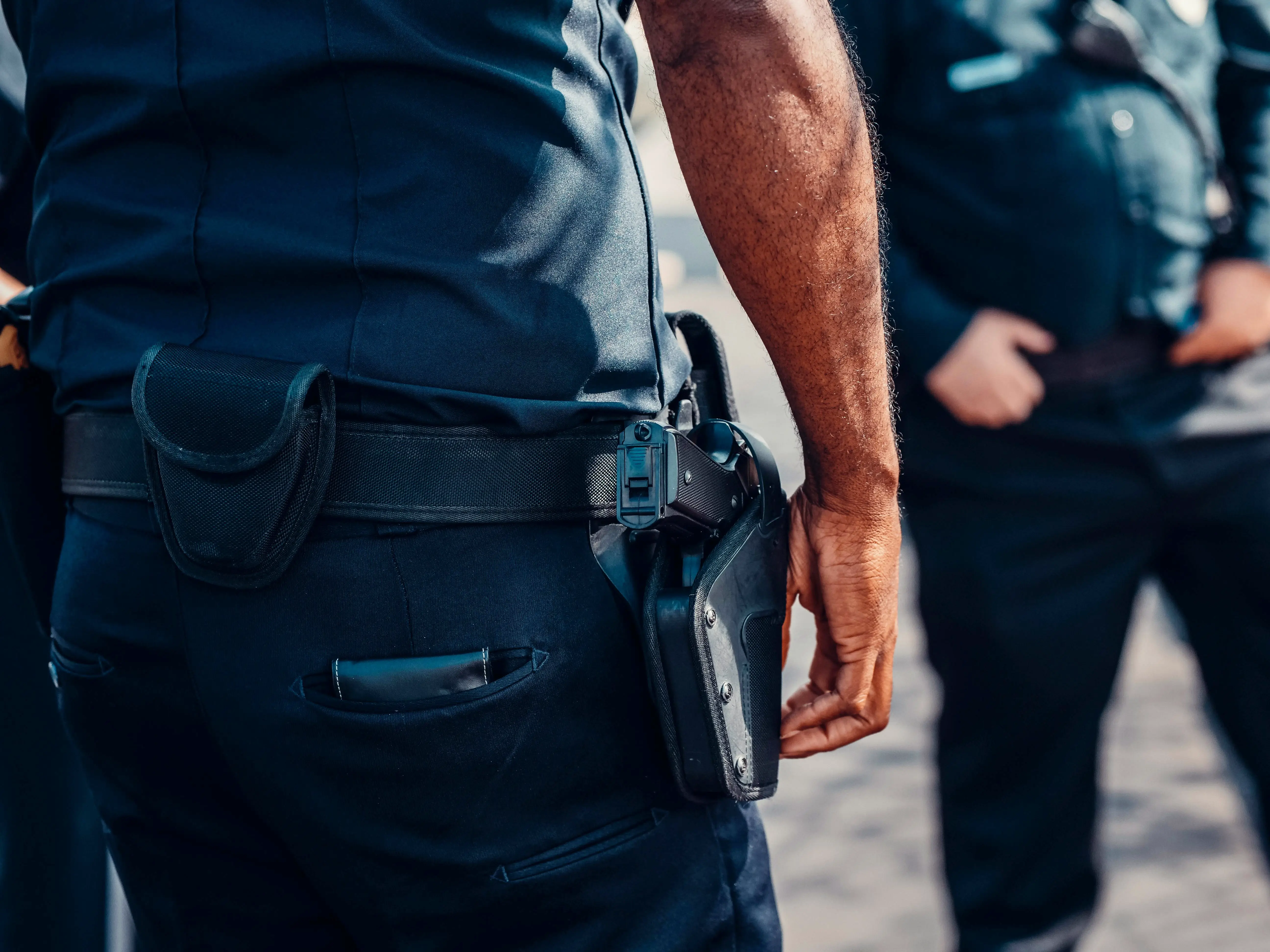
The weight of responsibility rests on every officer's hip - tools that may save lives or forever change them. Each shift begins with the hope that de-escalation and communication will be enough, that the equipment will remain holstered, and that everyone goes home safely.
Evidence from research on behavior changes has been mixed overall, but there are noteworthy trends. Several early studies found that use-of-force incidents and citizen complaints dropped after body cameras were adopted. In Rialto, CA – the site of a famous 2012-2013 experiment – use of force by officers fell by 50% and complaints against police plunged by 88% when cameras were worn. A Las Vegas study likewise saw double-digit percentage reductions in force and complaints after implementing cameras. These outcomes suggest that both officers and civilians behaved better when a camera was in play, confirming the "social surveillance" theory in those locales. However, later and larger studies have painted a more complex picture. A rigorous study of the Washington, D.C. Metropolitan Police (with over 2,000 officers) found no statistically significant differences in officer uses of force or citizen complaint rates between officers with cameras and those without. A 2020 meta-analysis reviewing dozens of bodycam studies similarly concluded that on average, body cameras had no consistent impact – neither strongly increasing nor decreasing metrics like use of force or arrests – across all agencies studied. These mixed results indicate that the context and policies surrounding the cameras matter a great deal. In departments that fully embraced cameras with training and clear expectations, the devices likely reinforced good behavior; in others, cameras alone did not automatically transform policing. Importantly, even where statistical outcomes (like force rates) did not change, body cameras still provided value in terms of evidence and transparency. Many agencies noted improvements in resolution of complaints and internal investigations – basically, even if an incident still occurred, it was easier to sort out what happened by reviewing footage. In Phoenix, for example, researchers found that officers wearing cameras were more likely to have complaints against them sustained (validated) rather than dismissed, presumably because video proved what actually occurred. From the officer's viewpoint, this means that good conduct can be validated and any bad conduct is harder to hide. Knowing this likely reinforces adherence to departmental policies and training, since officers recognize that deviations will be caught on tape. [Source]
Another area where cameras influence behavior is in officer discretion and decision-making. Some officers initially feared that having to follow the camera protocols would remove their flexibility – for example, they might feel compelled to make an arrest or issue a ticket in a borderline situation because the interaction was recorded, whereas in the past they might have given a stern warning and let someone go. In practice, most departments have not reported a loss of legitimate discretion; officers still exercise judgment, but they may articulate their reasons more clearly on camera. In fact, bodycam footage can back up an officer's discretionary calls. If a cop explains on video, "I'm issuing you a warning instead of a citation. Please fix this issue," that interaction is documented and can be reviewed if anyone questions why no enforcement action was taken. In this way, cameras can actually protect reasonable use of discretion by providing transparency. On the flip side, officers are also less able to look the other way on misconduct by fellow officers when cameras are recording. Policing has historically struggled with the "blue wall of silence," an informal code where officers might ignore or cover for a colleague's bad behavior. Body cameras make such omissions more difficult – if one officer's camera captures another officer behaving inappropriately, that footage creates a responsibility to act. Many officers take this in stride as part of the job's accountability, while others admit it adds pressure in the moment. Overall, though, the prevailing culture in many departments has shifted toward openness: officers know that adhering to the rules and treating people with respect aligns with what the camera records, and that is in everyone's best interest.
It's also worth noting that not every change in behavior has been positive or intended. In a few instances, research observed counterintuitive effects – for example, one study of the Phoenix Police found that certain officers increased their use of force when equipped with cameras. This was hypothesized to result from officers feeling a need to "perform" assertively on camera or from inconsistent policies that left officers unsure when to activate the camera, leading to more confrontational encounters in some cases. Such findings are outliers, but they highlight that simply adding a camera doesn't guarantee improved behavior; training and clear policy are key so that officers use cameras to complement de-escalation tactics, not as an excuse to be more forceful. By and large, though, police departments report that body-worn cameras have reinforced their officers' use of best practices. Many chiefs cite improved compliance with protocols – for instance, higher rates of officers following proper procedure during traffic stops and searches – after cameras were implemented, because any deviation would be evident on video. As one police supervisor observed, "The camera in essence keeps the officer's 'honor code' in check – they know they must do things by the book, and almost all of them do exactly that."
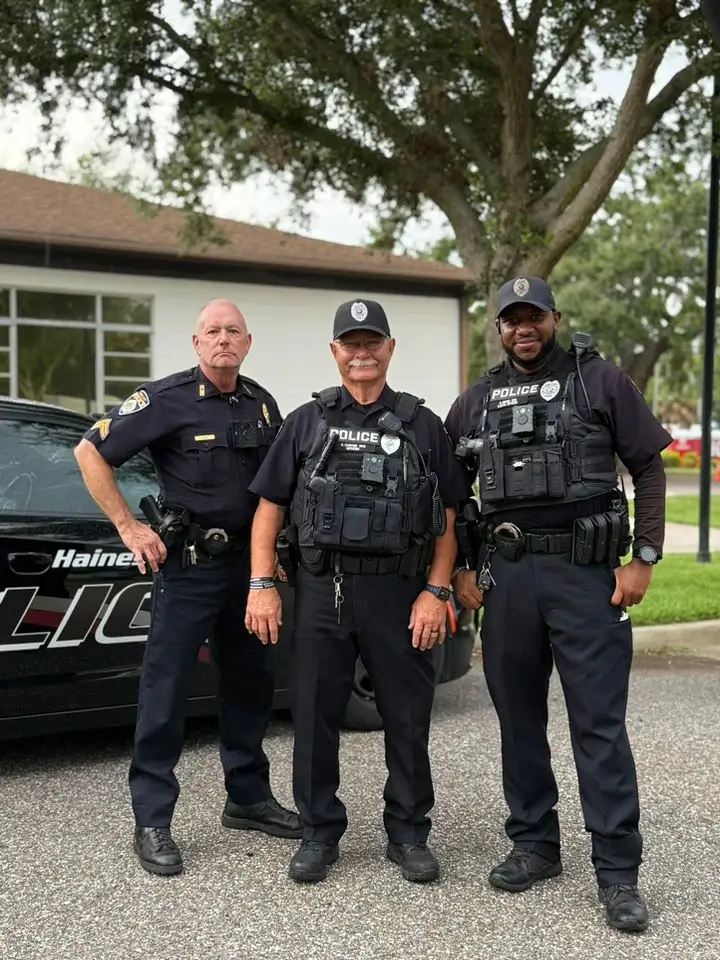
Haines Police officers stand ready to serve their community. Behind each badge are years of experience, countless calls answered, and the camaraderie that helps officers support each other through the challenges of the job.
From the perspective of everyday community interactions, body cameras have introduced more transparency and, arguably, more mutual respect in encounters. When an officer approaches a situation knowing it's being recorded, they often consciously strive to demonstrate professionalism – not just for the camera, but because they know the community is watching in a larger sense. Some departments have even begun using bodycam footage in training to highlight exemplary behavior, which incentivizes officers to be the one who gets it right on camera. Meanwhile, citizens, aware that an interaction is on video, may feel safer to speak up about what happened, knowing there is an objective record. The Golden Police Department in Colorado noted that the presence of BWCs strengthens accountability and assists in de-escalating conflicts between officers and community members. Their view – shared by many agencies – is that cameras encourage both parties to remain calm and courteous, "fostering an environment of mutual respect" during police-public interactions. While not every encounter is suddenly friendly just because a camera is recording, there is evidence that complaints against officers often decline once cameras are introduced, suggesting fewer instances of perceived rudeness or misbehavior. For officers, that trend can be gratifying: it implies that their efforts to be professional on camera are noticed and appreciated, leading to less friction with the public.
Body-worn cameras have influenced officer conduct by heightening awareness and accountability in daily duties. Most officers have adapted by incorporating the camera into their decision-making loop: Am I following policy? How will this look on video? These are questions in the back of an officer's mind that can guide them toward best practices. The result, in many cases, is more by-the-book policing and improved officer-citizen interactions. Although cameras are not a panacea – they have not eliminated all use-of-force controversies or complaints – they have undoubtedly added a measure of discipline and transparency to routine policing. For the conscientious officer, the body camera serves as a silent partner, one that can validate proper conduct and discourage lapses, ultimately improving the quality of service they provide to the community.
Accountability, Evidence, and Legal Implications
Beyond the immediate psychological and behavioral effects on officers, body cameras have significantly impacted police procedures, investigations, and legal processes. In many ways, the footage captured by an officer's bodycam has become the modern-day equivalent of a police report – a fundamental piece of evidence that can determine the outcome of disciplinary reviews, criminal investigations, and court cases. This new reality has led to changes in how officers handle incidents after the fact and how the justice system views officer testimony.
One major procedural change is in internal investigations and accountability mechanisms. Whenever a use-of-force incident or a civilian complaint arises now, one of the first steps for supervisors and investigators is to review the body camera footage. The video often provides clarity that written statements alone cannot. Cases that might have taken weeks of interviews and conflicting accounts to resolve can sometimes be closed in hours if the video clearly shows what occurred. For example, if a citizen files a complaint alleging an officer was discourteous or used excessive force, the department's professional standards unit can examine the bodycam recording to verify the claim. If the complaint is unfounded, the officer is quickly exonerated – a relief for the officer, who in the past might have had a cloud of suspicion lingering during a long investigation. Conversely, if the video reveals misconduct, the department can respond with appropriate discipline or retraining, demonstrating accountability. Either way, body cameras help "speed up the truth-finding process" and make outcomes more objective. A National Institute of Justice review noted that bodycams led to faster resolution of complaints and improved the evidentiary quality of internal affairs investigations. In a multi-site study, departments with body cameras saw a higher percentage of complaints against officers being sustained (validated) and fewer being dismissed for lack of evidence. From an officer's perspective, this can be a double-edged sword: the camera can vindicate them when they're right, but it will also provide proof if they're wrong. Many officers have adjusted to this by erring on the side of adherence to policy at all times. The certainty of video evidence has instilled a stronger sense of accountability. As one police chief put it, "the camera's memory is better than ours – knowing that, our officers make sure to do the right thing, because there's no hiding from the record." [Source]
Another debate in the procedural realm has been whether officers should review bodycam footage before writing reports or giving statements about an incident. Historically, many agencies allowed (even encouraged) officers to watch their camera footage to refresh their memory when filling out reports. The rationale was that this would ensure accuracy and detail. However, critics argued this practice could unintentionally or intentionally enable officers to align their reports with the footage and potentially omit subjective details (like what the officer felt or perceived) that aren't evident on video. There's also a concern that an officer's initial recollection might differ from what the video shows (due to stress or angle), and seeing the video could "rewrite" their memory. In recent years, some departments and prosecutors have pushed back against automatic pre-report viewing of footage. Policies have started to change: in 2019, about 92% of departments still let officers review footage before making a statement, but by 2022 that figure had dropped to 56%. The trend is toward requiring an initial report or statement based on the officer's recollection, capturing the officer's perspective, and then allowing review of footage for supplemental details. This approach can protect the integrity of investigations (especially in officer-involved shootings or use-of-force cases) by preserving what the officer thought was happening, alongside what the camera recorded. Many officers understand the reasoning – it can actually defend an officer if the video shows something the officer couldn't have seen at the time, confirming that any divergence was due to vantage point, not deception. Still, the shift has been an adjustment: it's another example of how body cameras have woven into legal procedures, sometimes altering long-standing practices to balance accountability with fairness to officers.
When it comes to criminal investigations and court proceedings, body camera footage has proven to be a game-changer. Prosecutors and defense attorneys alike now expect to see video evidence as part of most cases involving police encounters. According to one estimate, over 80% of criminal cases now involve some form of video evidence, often from police bodycams or dashcams. For officers, this means their camera footage might be played in court to supplement (or scrutinize) their testimony. In the courtroom context, bodycam video is extremely valuable for corroborating an officer's account, clarifying timelines, and resolving ambiguities that might otherwise cloud a case. Jurors tend to find video evidence compelling because it's seen as more objective than just witness statements. For instance, if an officer testifies about a suspect resisting arrest, the bodycam video can show the suspect's actions, the officer's commands, and the level of force used, all of which help the jury determine what happened. This often leads to swifter justice: cases with clear bodycam footage can be resolved faster and with fewer disputed facts. Officers generally appreciate this, since it means that if they acted properly, the video will speak louder than any accusations. It can also save them from lengthy court appearances or multiple hearings; a solid video can prompt a defendant to plead guilty, or a prosecutor to drop charges, without putting the officer through a protracted trial.
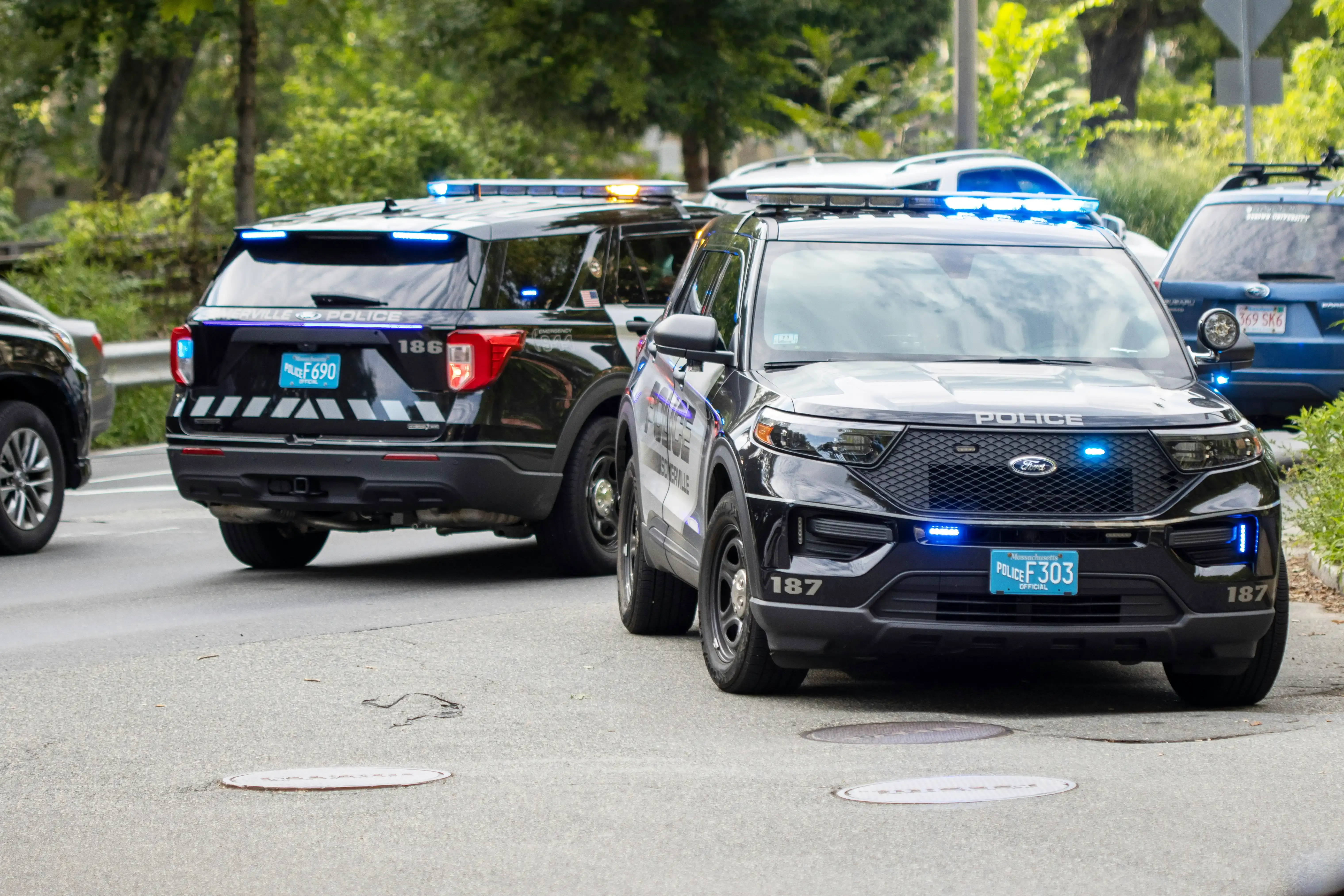
Police vehicles respond to another call, lights flashing with urgency. Behind each steering wheel is an officer heading toward the unknown - it could be a routine traffic stop, a family in crisis, or a life-threatening situation. The uncertainty of each response weighs heavily on those who answer the call.
However, the use of bodycam footage in legal settings is still evolving, and it's not without complications. One issue is that video can't capture everything, and it may not perfectly reflect an officer's perception. Cameras are typically mounted on the chest or glasses, so they show roughly what the officer sees, but they might miss where the officer's eyes were looking or what was happening outside the camera's frame. There have been instances where an officer's split-second decision (for example, perceiving a threat and using force) is second-guessed because the camera angle didn't clearly show the suspect's gesture that the officer reacted to. This is why many training programs remind jurors and reviewers that "the camera perspective is not the same as the human perspective." Courts have generally upheld that bodycam footage is a supplement to, not a replacement for, an officer's testimony. In fact, a recent ruling in California underscored that video of a witness statement could not simply stand in for live witness testimony in court – highlighting that while video is powerful evidence, it must be used in context with other evidence and rights (like cross-examination). From an officer's standpoint, this means they still must write detailed reports and be prepared to explain their actions in person, even if video exists. The camera doesn't remove the need for officer professionalism in documentation; rather, it complements it and holds it to a higher standard. [Source]
Body cameras have also introduced new legal and logistical considerations for police agencies. One is data management: storing and managing thousands of hours of video is expensive and complex. Departments must follow laws and policies on how long footage is retained (often longer for serious incidents, shorter for routine encounters), who can access or release it, and how to handle privacy concerns (since videos may capture bystanders, victims, or inside private homes). Many states have passed laws addressing public disclosure of bodycam footage to balance transparency with privacy. For example, videos involving juveniles or inside homes might be exempt from public release, or require redaction. Officers have had to learn these rules as well – they may need to tag videos with case numbers or categories that determine retention and review protocols. While these procedural details don't directly affect an officer's psychology in the field, they do shape how officers think about the footage they collect. Knowing that a video will be stored and potentially scrutinized, officers are careful to follow through with uploading footage after shifts and documenting any notable events captured. Police departments have trained officers on the importance of this digital evidence chain of custody, because a lost or mishandled video can derail a prosecution or erode public trust. In essence, body cameras have made every officer a collector of evidence in even routine incidents, and this responsibility is now part of the job.
Finally, bodycam footage is increasingly used for training and policy review, which brings a positive feedback loop to officer behavior. Many agencies conduct periodic audits of random bodycam videos or use clips (with permission and redaction) to highlight examples of both exemplary police work and areas for improvement. Officers, knowing this, often strive to be the positive example. The footage has been used to develop better training scenarios – for instance, analyzing videos of de-escalation encounters that went well, or examining incidents that escalated to see how they could be handled differently. This continuous learning aspect creates an environment where officers see body camera footage as a tool for growth, not just oversight. It can be oddly rewarding for an officer to have a supervisor say, "I reviewed your bodycam from that domestic call – you did an excellent job calming the situation." Such feedback reinforces good practices and shows officers that the camera can spotlight their professionalism in a positive way.
A New Era of Policing with Eyes Wide Open
In the span of a decade, body-worn cameras have changed the landscape of American policing. They serve as an ever-present witness to police encounters – "the witness within" each officer's uniform – and have consequently influenced both the mindset and actions of officers on the street. Historically, policing relied on the officer's word and written reports to stand as the record of events. Now, with cameras, there is a fuller record, and that reality has made officers more conscious, more accountable, and at times more cautious in how they do their jobs. From the early trepidation about being filmed to the current perspective that cameras are a valuable asset, officers have navigated a significant psychological shift. Many have found that the benefits of bodycams – in validating their good work, improving their safety, and strengthening community trust – outweigh the initial worries. The presence of a camera has encouraged officers to uphold the highest standards of professionalism consistently, knowing that their actions are transparent. It has also given them confidence that if they are unfairly accused, the truth is likely tucked away in their video files.
For the public, understanding this evolution from the officer's point of view is crucial. Body cameras are not a magic fix for every issue in policing, but they have ushered in a new era of transparency and self-awareness in law enforcement. The modern police officer operates with "eyes wide open," aware that their camera is capturing each moment for posterity. This has brought challenges – added stress, technical burdens, and procedural changes – but also significant strides in accountability and evidence-based policing. As agencies continue to refine how bodycam footage is used, with supportive policies and respect for both officers and citizens, the technology stands to further improve police-community relations. In the end, body-worn cameras have become more than just gadgets clipped to a uniform; they are catalysts for cultural change in policing. The camera's lens has, in many ways, helped officers see themselves the way the public sees them, leading to adjustments and improvements in their conduct. And for the community, knowing that officers are routinely recording their actions has bolstered confidence that integrity and transparency are core values in modern law enforcement.
The story of body cameras in policing is still being written, with ongoing research and evolving practices. Yet it's clear that the simple act of hitting "record" has had profound implications for officer psychology and behavior. By appreciating these changes, the public can better understand the pressures and professionalism of officers in the camera age. The body-worn camera, as the witness within, watches over the actions of those who watch over us – and in doing so, it has helped shape a new standard of policing built on accountability, evidence, and trust.

